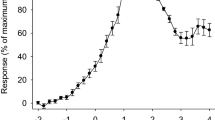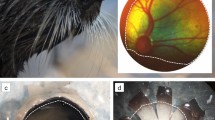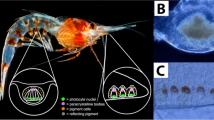Abstract
We investigated the effect of environmental hypoxia on vision in snapper (Pagrus auratus). Juvenile snapper inhabit estuarine environments where oxygen conditions fluctuate on a seasonal basis. Optomotor experiments demonstrated that visual acuity is impaired by environmental hypoxia, but not until levels approach the critical oxygen tension (P crit) of this species (around 25 % air-saturated seawater). In 100, 80, and 60 % air-saturated seawater, a positive optomotor response was present at a minimum separable angle (M SA) of 1°. In 40 % air-saturated seawater, vision was partially impaired with positive responses at M SAs of 2° and above. However, in 25 % air-saturated seawater, visual acuity was seriously impaired, with positive responses only present at M SAs of 6° and above. Snapper were found to possess a choroid rete, facilitating the maintenance of high ocular oxygen partial pressures (PO2) during normoxia and moderate hypoxia (PO2, between 269 and 290 mmHg). However, at 40 and 25 % water oxygen saturation, ocular PO2 was reduced to below 175 mmHg, which is perhaps linked to impairment of visual acuity in these conditions. The ability to preserve visual function during moderate hypoxia is beneficial for the maintenance of a visual lifestyle in the fluctuating oxygen environments of estuaries.




Similar content being viewed by others
References
Barbazetto IA, Liang J, Chang S, Zheng L, Spector A, Dillon JP (2004) Oxygen tension in the rabbit lens and vitreous before and after vitrectomy. Exp Eye Res 78:917–924
Bilotta J (2000) Effects of abnormal lighting on the development of zebrafish visual behaviour. Behav Brain Res 116:81–87
Brietburg D (2002) Effects of hypoxia and the balance between hypoxia and enrichment on coastal fishes and fisheries. Estuaries 25:767–781
Cook DG, Wells RMG, Herbert NA (2011) Anaemia adjusts the aerobic physiology of snapper (Pagrus auratus) and modulates hypoxia avoidance behaviour during oxygen choice presentations. J Exp Biol 214:2927–2934
Crossland J (1981) The biology of the New Zealand snapper. Fish Res Div Occas Publ 23:1–15
Diaz RJ, Brietburg DL (2009) The hypoxic environment. In: Richards JG, Farrell AP, Brauner CJ (eds) Hypoxia. Academic Press, London, pp 2–25
Douglas RH, Hawryshyn CW (1990) Behavioural studies of fish vision: an analysis of visual capabilities. In: Douglas RH, Djamgoz MBA (eds) The visual system of fish. Chapman and Hall, London, pp 373–418
Harden-Jones FR (1964) The reaction of fish to moving backgrounds. J Exp Biol 40:437–446
Herbert NA, Wells RMG (2002) The effect of strenuous exercise and β-adrenergic blockade on the visual performance of juvenile rainbow trout Oncorhynchus mykiss. J Comp Physiol B 172:725–731
Herbert NA, Wells RMG, Baldwin J (2002) Correlates of choroid rete development with the metabolic potential of various tropical reef fish and the effect of strenuous exercise on visual performance. J Exp Mar Biol Ecol 275:31–46
Herbert NA, Macdonald JA, Wells RMG, Davison W (2003) A difference in optomotor behaviour of two Antarctic nototheniid fishes is correlated with the presence of a choroid rete mirabile and root effect. Polar Biol 26:411–415
Herbert NA, Steffensen JF, Jordan AD (2004) The interrelated effects of body size and choroid rete development on the ocular O2 partial pressure of Atlantic (Gadus morhua) and Greenland cod (Gadus ogac). Polar Biol 27:748–752
Jackson G, Norris JV, Mackie MC, Hall NG (2010) Spatial variation in life history characteristics of snapper (Pagrus auratus) within Shark Bay, Western Australia. N Z J Mar Freshw Res 44:1–15
Janssen JGA, Jerrett A, Black SE, Forster ME (2010) The effects of progressive hypoxia and re-oxygenation on cardiac function, white muscle perfusion and haemoglobin saturation in anaesthetised snapper (Pagrus auratus). J Comp Physiol B 180:503–510
Johansson D, Nilsson GE, Doving KB (1997) Anoxic depression of light-evoked potentials in retina and optic tectum of crucian carp. Neurosci Lett 237:73–76
Lague SL, Speers-Roesch B, Richards JG, Farrell AP (2012) Exceptional cardiac anoxia tolerance in tilapia (Orechromis hybrid). J Exp Biol 215:1354–1365
Patel BN (2011) The response of juvenile snapper, Pagrus auratus, to environmental hypoxia and oxygen profiles in the Mahurangi Estuary, Auckland Region. MSc thesis, University of Auckland, New Zealand
Petersen LH, Gamperl AK (2010) Effect of acute and chronic hypoxia on the swimming performance, metabolic capacity and cardiac function of Atlantic cod (Gadus morhua). J Exp Biol 213:808–819
R Development Core Team (2011) R: a language and environment for statistical computing. R Foundation for Statistical Computing, Vienna. http://www.R-project.org. Accessed 29 Mar 2012
Regan MD, Brauner CJ (2010) The evolution of root effect hemoglobins in the absence of intracellular pH protection of the red blood cell: insights from primitive fishes. J Comp Physiol B 180:695–706
Richards JG (2011) Physiological, behavioural and biochemical adaptations of intertidal fishes to hypoxia. J Exp Biol 214:191–199
Robinson E, Jerrett AR, Black SE, Davison W (2011) Visual acuity of snapper (Pagrus auratus): effect of age and spectral composition. J Fish Biol 79:1883–1894
Roesner A, Hankeln T, Burmester T (2006) Hypoxia induces complex response of globin expression in zebrafish (Danio rerio). J Exp Biol 209:2129–2137
Shimps EL, Rice JA, Osborne JA (2005) Hypoxia tolerance in two juvenile estuary-dependent fishes. J Exp Mar Biol Ecol 325:146–162
Waser W, Heisler N (2005) Oxygen delivery to the fish eye: root effect as crucial factor for elevated retinal PO2. J Exp Biol 208:4035–4047
Williams DL, Brancker WM (2004) Intraocular oxygen tensions in normal and diseased eyes of farmed halibut. Vet J 167:81–86
Wittenberg JB, Wittenberg BA (1962) Active secretion of oxygen into the eye of fish. Nature 194:106–107
Wittenberg JB, Wittenberg BA (1974) The choroid rete mirabile of the fish eye I. Oxygen secretion and structure: comparison with the swimbladder rete mirabile. Biol Bull 146:116–136
Wu RSS (2002) Hypoxia: from molecular responses to ecosystem responses. Mar Pollut Bull 45:35–45
Yaqoob N, Schwerte T (2010) Cardiovascular and respiratory developmental plasticity under oxygen depleted environment and in genetically hypoxic zebrafish (Danio rerio). Comp Biochem Physiol A 156:475–484
Acknowledgments
We thank Sharon Ford and the staff of Plant and Food Research Nelson for snapper culture and transport and Peter Alspach for statistical analysis. Thank you also to Gavin Robinson, Alan Woods and Nick Etheridge for technical expertise and construction of the optomotor apparatus, to Manfred Ingerfeld and Matt Walters for photographic work and Karen Middlemiss for experimental assistance. We appreciate the comments of two anonymous reviewers who provided valuable comment on the manuscript. The experimental procedures were approved by the University of Canterbury Animal Ethics Committee.
Author information
Authors and Affiliations
Corresponding author
Rights and permissions
About this article
Cite this article
Robinson, E., Jerrett, A., Black, S. et al. Hypoxia impairs visual acuity in snapper (Pagrus auratus). J Comp Physiol A 199, 611–617 (2013). https://doi.org/10.1007/s00359-013-0809-7
Received:
Revised:
Accepted:
Published:
Issue Date:
DOI: https://doi.org/10.1007/s00359-013-0809-7




